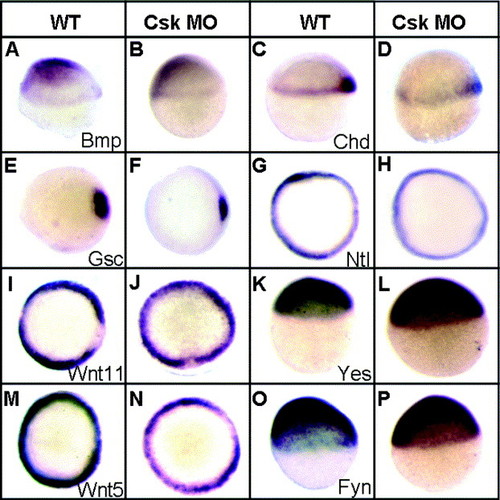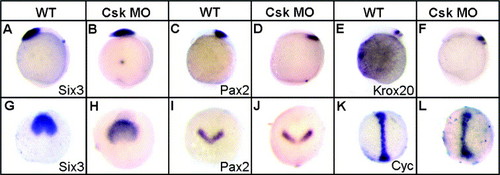- Title
-
Essential role for Csk upstream of Fyn and Yes in zebrafish gastrulation
- Authors
- Jopling, C., and den Hertog, J.
- Source
- Full text @ Mech. Dev.
|
Csk is ubiquitously expressed in early zebrafish development. (A) Schematic representation of zebrafish Csk with one Src homology 3 (SH3) domain and one Src homology 2 domain to the N-terminal side of the protein-tyrosine kinase domain. The overall sequence identity with human and mouse Csk is indicated. (B–F) In situ hybridization with a Csk-specific antisense probe at various stages of development: (B) 8 cell-stage; (C) 4 hpf; (D) shield stage; (E) 10 hpf and (F) 14 somite (14 s). EXPRESSION / LABELING:
|
|
Csk knockdown induced defects associated with impaired gastrulation. Zebrafish embryos were not injected (A) or microinjected with Fyn/Yes-MO (5 ng) (B) or Csk-MO (5 ng) (C) at the 1 cell stage and allowed to develop. (A–C) Morphology at 10 hpf shows reduced anterior extension of the Fyn/Yes-MO and Csk-MO injected embryos. (D) Csk knock down embryos at 3 dpf show a reduction in overall length (uninjected at the top). (E) Rescue of the Csk knock down phenotype by co-injection of synthetic human csk mRNA. Zebrafish embryos were injected with Csk-MO (5 ng) alone or in conjunction with human csk mRNA (150 pg). The length of the embryos was measured at 3 dpf and the average is shown here. Two tailed student t-tests indicate a significant decrease in length after injection of Csk-MO alone (P < 0.001, single asterisk) and a significant increase in the length after co-injection of csk mRNA (P < 0.001, double asterisk). PHENOTYPE:
|
|
CE cell movement defects in response to Csk knock down. (A) and (B) Embryos were loaded with caged fluorescein dextran and the fluorophore was uncaged at the shield stage (6 hpf) dorsally to determine anterior extension (A) or laterally to determine dorsal migration (B). Cell labelings of the same embryos were followed immediately after uncaging, at 80% epiboly, 8 hpf and at tailbud stage, 10–10.5 hpf. Wild-type and Csk-MO injected embryos were assessed. (A) Anterior extension (white arrow) from the site of uncaging (black arrowhead) was quantified at tailbud stage and is depicted as degrees anterior movement (inset is lateral view of a 10 hpf embryo, anterior at the top). (B) Dorsal migration (white arrow in inset) relative to the initial position at the shield stage (black arrowhead) was quantified at tailbud stage as degrees from dorsal (inset is a frontal view with dorsal to the top). |
|
Csk knock down did not affect cell specification, nor expression of known regulators of CE cell movements. Csk-MO injected embryos were fixed at 6 hpf and in situ hybridization was done with various probes: (A and B) bone morphogenetic protein 2b, bmp; (C and D) chordin, chd; (E and F) goosecoid, gsc; (G and H) no tail, ntl; (I and J) wnt11; (K and L) yes; (M and N) wnt5; (O and P) fyn. Either lateral views (A–D, K, L, O, and P) or animal pole views (E–H, I, J, M, and N) are depicted here. EXPRESSION / LABELING:
|
|
Csk knock down induced a posterior shift. Molecular markers indicate there is no deletion of anterior structures only a posteriorwards shift in expression. Control and Csk-MO injected embryos were fixed at 10 hpf (A–J) or 8 hpf (K and L) and in situ hybridizations were done with the indicated probes: (A,B,G, H) six3; (C,D,I,J) pax2; (E and F) krox20; (K and L) cyclops, cyc. Lateral views (A–F) or dorsal views with anterior to the top (G–L) are depicted here. EXPRESSION / LABELING:
|
|
Csk acts upstream of Fyn and Yes in gastrulation cell movements. The Csk-MO (5 ng) was injected alone or together with human csk mRNA (150 pg) or low levels of Fyn/Yes-MO (0.125 ng each, low). As a control, high levels of Fyn- and Yes-MOs that induce CE defects were injected (5 ng each, high). The angle between the most anterior and posterior embryonic structure was determined at the 1-somite stage in at least 20 embryos and the average angle is depicted here in degrees. Two tailed student t-tests indicate a significant increase in the angle after injection of Csk-MO alone (P < 0.001, single asterisk) and a significant decrease in the angle after co-injection of csk mRNA or Fyn/Yes-MO (P < 0.001, double asterisk). PHENOTYPE:
|
Reprinted from Mechanisms of Development, 124(2), Jopling, C., and den Hertog, J., Essential role for Csk upstream of Fyn and Yes in zebrafish gastrulation, 129-136, Copyright (2007) with permission from Elsevier. Full text @ Mech. Dev.






